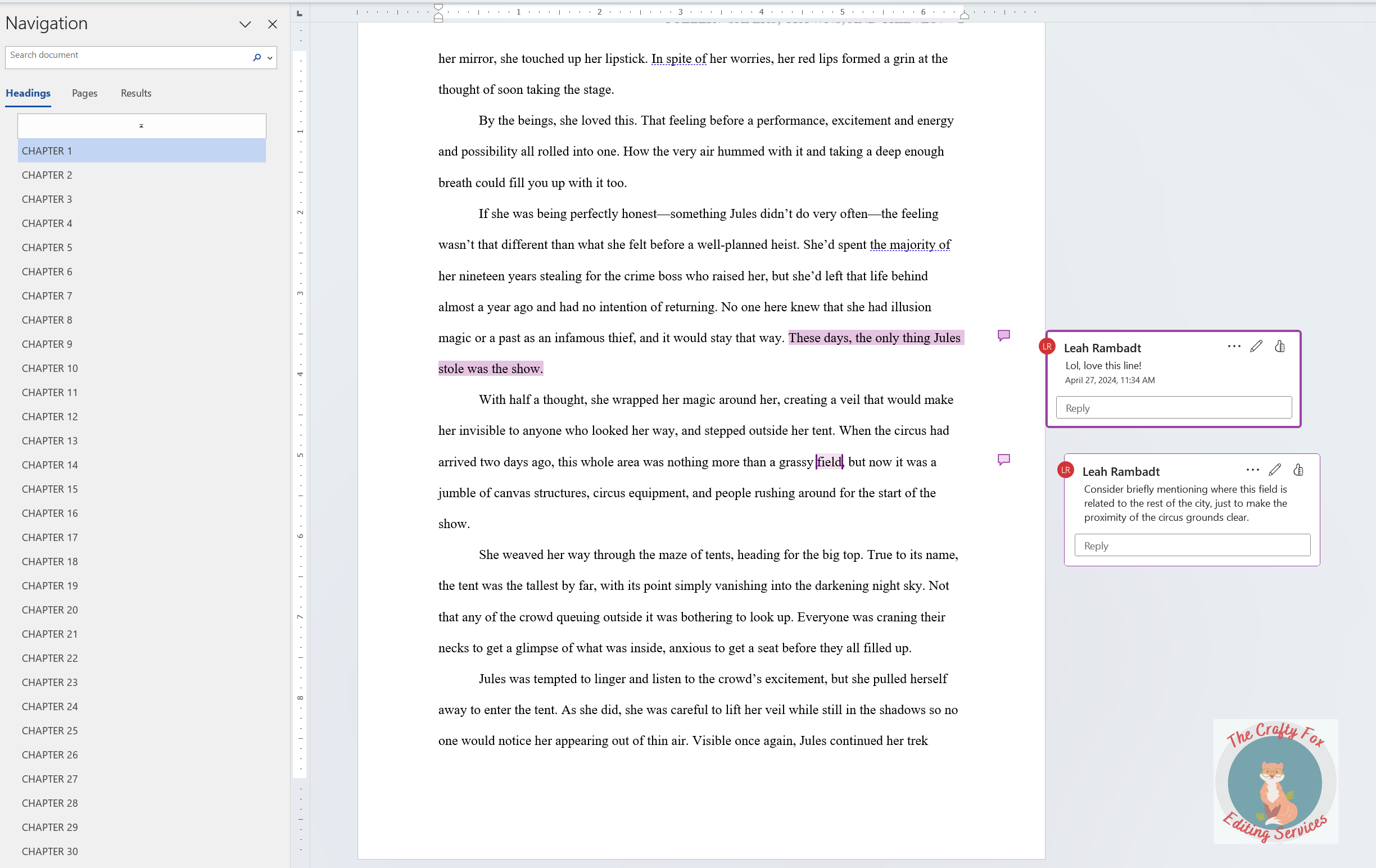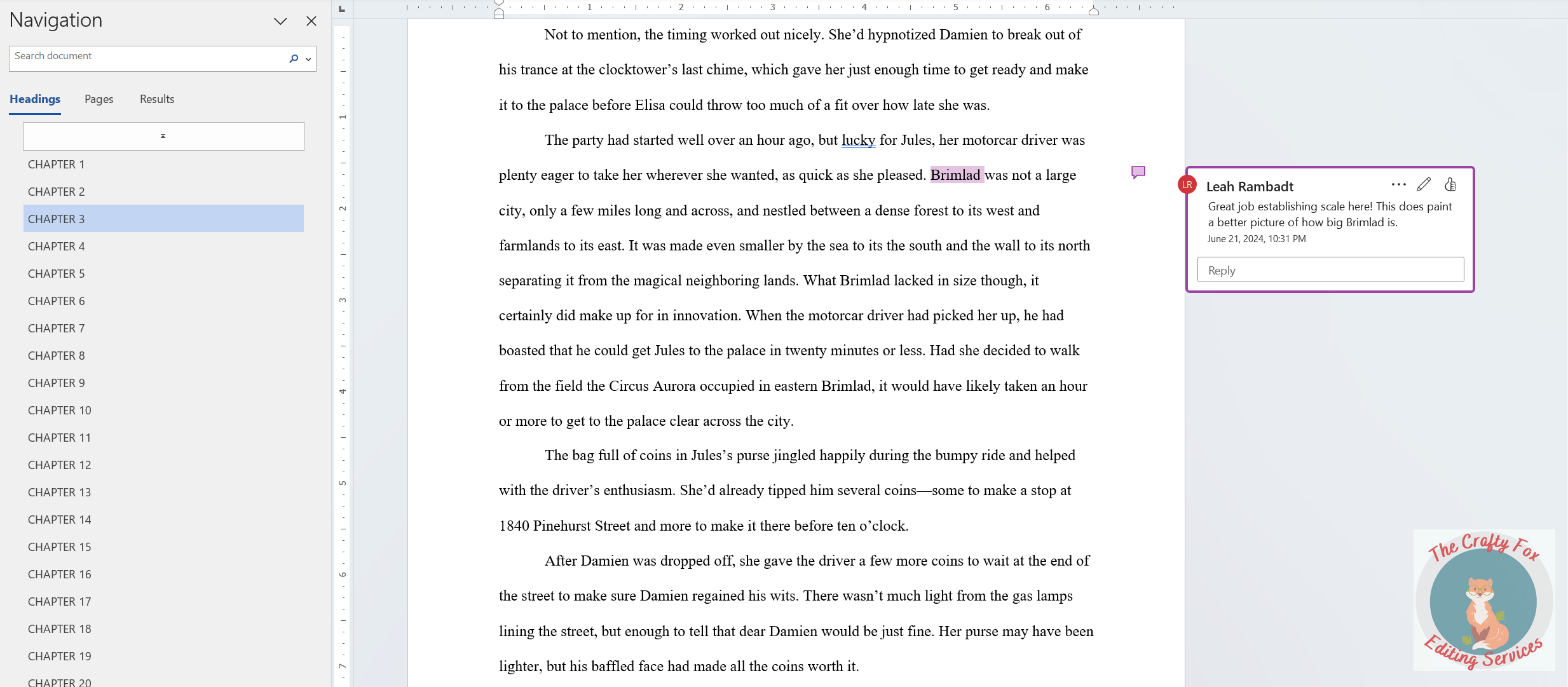Editing Insights: Developmental Editing
A behind-the-scenes look of a developmental edit with me!
Hi Story Crafters,
As mentioned in the previous post, we’ll take a look at what a developmental editing (or dev edit) package looks like from me. Included are screenshot examples of the deliverables in a dev editing package (the developmental editing tracking sheet, the edited manuscript + comments, and the editorial letter) with the author’s permission.
For a general overview of my editing process, check out the Editing Process Insight: A General Overview of My Editing Process post.
As a reminder, this is how I define developmental editing.
Developmental Editing
Also known as substantive editing. I check which storytelling elements (especially character development) are effective, and which aren’t as effective, from a “big picture” perspective of the manuscript as a whole. This includes evaluating how these elements work within chapters as well.
My overall goal for developmental editing is to make sure your story has a strong narrative arc your readers will want to follow, and interesting characters they’ll want to know and care about.
The deliverables include:
The edited manuscript with comments
The developmental editing tracking sheet
The editorial letter
To review more details about what each deliverable is, please visit the Editing Process Insight: Developmental Editing from The Crafty Fox Editing Services post.
1) Edited Manuscript with Comments
For a dev edit, I leave very few in-manuscript edits. Comments are left as needed throughout the manuscript, to point out areas of strength, possible sources of confusion, and suggestions for improvement. These comments are expanded on in the editorial letter.
Screenshot of manuscript (MS) dev edit Round 1:
Screenshot of MS at the start of Round 2, after the author reviews and responds to certain comments. This is easily my favorite part about the editing process because I’m in conversation with the author, getting my own feedback about what the author thinks is working, how they think they can make improvements, or just explaining certain details I misunderstood.
Round 2 of editing, in response to author incorporating Round 1 suggestions. And of course, the author needs feedback on whether they implemented Round suggestions effectively, so that’s the main focus of my comments for Round 2 edits.
2) Developmental Editing Tracking Sheet
I use this sheet to note and track the consistency of details in the manuscript, including character names, character descriptions, location names, and tracking the passage of time. This is probably most useful after Round 1, unless drastic changes are implemented before the MS is sent back for Round 2 edits.
Screenshot of timeline/chapter breakdown:
Screenshot of character names and descriptions, and setting names and first mentions:
3) Editorial Letter
The editorial letter is where the main weight lies for a developmental edit from me. I address areas of strength, areas for the author to consider during revision, and any areas of interest the author wants me to review specifically (e.g., how effective the storytelling is in keeping reader engagement).
I cite specific examples from the manuscript, and expand on comments made in-manuscript in greater detail. I’m a big fan of using the Headings style in Word for organization and navigation in the editorial letter, along with bullet points and font styles.
Screenshot of feedback for elements that are working well:
Screenshot of elements that could be improved:
Screenshot of feedback for character relationships—what’s working, what could be improved.
I hope this helps paint a better picture of what a developmental editing package from me looks like!
*Current subscribers can find a downloadable version of the dev editing tracking sheet in the email footer. Not a subscriber? Subscribe to this newsletter to get this tracking sheet and a guide for relationship mapping for your major characters!
How do I know I’m looking for developmental editing services?
When you’re looking into a developmental editing service, the type of feedback you’re looking for includes:
Big picture edits – You’re confident in your storyline up to a certain point, and you need another set of eyes to help you confirm where the strengths and areas of improvement are. If there are areas that can be improved, you’re interested in receiving feedback and suggestions on how to move forward to improve your story.
Elements of writing – You’re confident in some areas of writing, and not as confident in others. For example, you know you’re on point with capturing your characters’ dialogue, but you aren’t sure if their development (as an individual character, or their relationships with other characters) is progressing as it should. No matter the case, you’re again interested in receiving feedback on what is and isn’t working effectively, and in receiving suggestions on how to improve your story.
Consistency – This may overlap with the previous sections, but in general, you’re interested in another set of eyes tracking specific details in your story. This could mean tracking time (as in, the progression of or counting down time to a deadline), tracking character development, tracking movement in a given space, etc.
Note: This differs from a copyedit in the sense that these details are important factors of the plot. In other words, if these details need to be adjusted, the entire storyline might need to be reworked. Tracking consistency in a copyedit is more along the lines of, it was nighttime at the beginning of the scene and somehow noon by the end without a clear transition, or a character’s appearance changing drastically from first appearance and the middle of the story without explanation.
If you’re interested in working with me on a developmental edit, please get in touch! If the author-editor fit is good, we can book a block of time for your developmental edit in advance so we can get started as soon as you finish your manuscript.
Also, in case you missed it, Flights of Foundry will be happening next month, September 27-29! This is a global, virtual conference for speculative fiction creators across all mediums, so if you’re interested in interacting with other speculative fiction (fantasy, sci-fi, horror) authors and other creators, consider checking it out!
Best,
Leah
Interested in learning more about me, and the kind of energy I’ll bring to the author-editor relationship? Subscribe to this newsletter (it’s free!).










